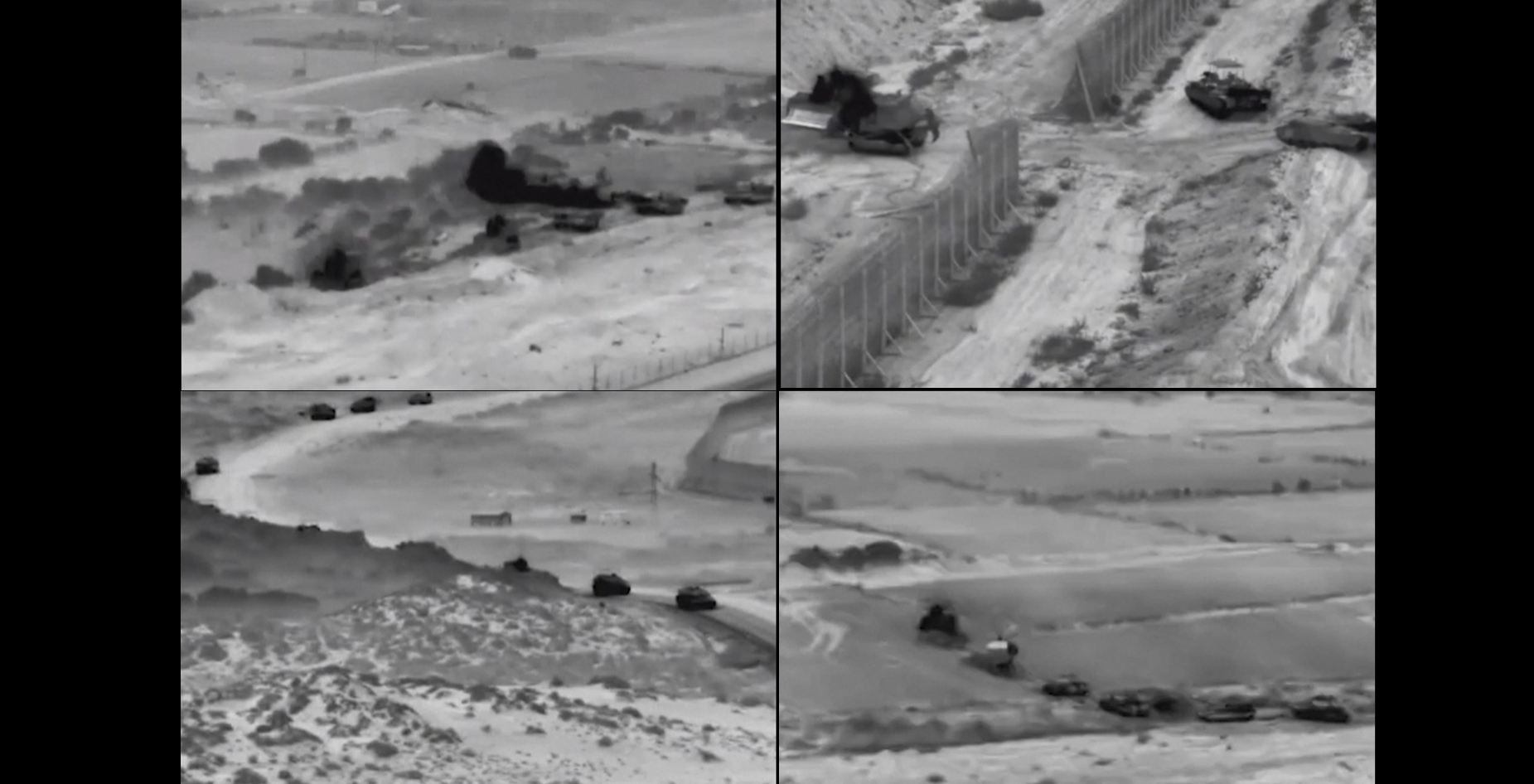
Amid rising tensions in the Gaza Strip, the Israeli military announced on Thursday that it has sent tanks to the north of the enclave as part of preparations for the next phase of fighting. This move came after Prime Minister Benjamin Netanyahu indicated that a ground invasion of Gaza was an imminent possibility.
This is not the first time that Israel has conducted a limited ground incursion into Gaza during this conflict. Two weeks ago, the country reported that some of its troops had briefly entered the territory. Details of the latest ground incursion remain scarce, with the Israeli military disclosing only that it struck several targets and “operated to prepare the battlefield.”
Video footage released by the Israeli military shows tanks firing inside Gaza territory, in an area close to the northern border and the Mediterranean Sea.
Nearly three weeks into the war, it remains uncertain whether Israel will launch a ground invasion of Gaza and, if it does, what its scope will be. In a televised speech on Wednesday night, Prime Minister Netanyahu did not provide specific details about the possible invasion, but assured that Israel would make Hamas pay for what he called the “October invasion.”
Read also: Israel bans visas for the UN and calls for Guterres to resign after speech
Israel has launched an intense series of airstrikes on Gaza, with more than 250 attacks in the last day, according to information from its military. Israel claims its targets are militants from Hamas and other armed groups, but Palestinians accuse the country of killing civilians indiscriminately.
The Gaza Ministry of Health reported that more than 7,000 people have lost their lives since the conflict began. A day after US President Joe Biden expressed suspicion about the death toll in Gaza, the Ministry released a list of 6,747 names of people who had died in Israeli airstrikes since October. Of this total, 2,665 were children. The ministry said another 281 people could not be identified due to the nature of their lethal injuries.
Postponement to protect US troops
Amid the ongoing conflict in the Gaza Strip, Israel has temporarily postponed its expected ground invasion of the region, following a request from the United States. This would allow more time to reinforce the protection of American troops at bases in the region, as well as negotiate the release of hostages and facilitate the entry of humanitarian aid into Gaza. The Biden administration also expects the Israeli military to review its military objectives and avoid an overwhelming urban conflict that could result in large numbers of casualties.
Read also: Conflict in Palestine makes Arab countries rethink relations with Israel
The Pentagon is working to deploy nearly a dozen air defense systems in the region, including those intended to protect U.S. troops stationed in countries including Iraq, Syria, Kuwait, Jordan, Saudi Arabia and the United Arab Emirates. US officials have reportedly managed to persuade Israel to postpone the invasion until these defense systems can be deployed, which should occur later this week.
In addition to considering the safety of its own troops, Israel claims to be taking into account efforts to provide humanitarian aid to civilians in Gaza and diplomatic initiatives to free hostages held by Hamas. However, the UN complains about the impossibility of providing adequate humanitarian aid, due to impediments imposed by Israel, in addition to its own relentless bombings, even in areas that the Israeli government claims it is not attacking.
Disproportionality
Israel’s 19-day bombing campaign in Gaza has become one of the most intense of the 21st century, provoking growing global scrutiny of its scale, purpose and cost to human life. The Israeli military says it has struck more than 7,000 targets inside Gaza. This is a higher number than in any previous Israeli military campaign in the territory, a narrow enclave less than half the size of New York City. It also surpasses the most intense month of the US-led bombing campaign against ISIS, according to Airwars, a British conflict monitor.
Read also: Arab world is disillusioned by the hypocrisy of the powers and support for Israel
The figure reported by the Gaza Ministry of Health, if confirmed, would make this conflict the deadliest for Palestinians since at least the 1982 Lebanon war.
Officials and analysts warn that a potential ground invasion of Gaza could be even bloodier than the air war. They argue that strikes that facilitate the Israeli ground advance will help reduce the loss of life of both Palestinian civilians and Israeli soldiers once the invasion begins.
Since October 7, Israel says it has targeted dozens of Palestinian rocket launchers, command centers and munitions factories. It also used powerful bombs to penetrate the surface in order to destroy a network of tunnels, hundreds of kilometers long, that armed groups such as Hamas had dug deep into the territory’s most populous urban centers.
Wide and unrestricted target
Although Israel has used precision weapons, its definition of what constitutes a military target is very broad. Fighter jets destroyed the Islamic University in Gaza because Israel said the campus had been used to train intelligence agents. They have targeted mosques that Israel says served as weapons depots and operations centers. And they target Hamas commanders in their homes.
Read also: Lula criticizes Israel and says that terrorism does not justify the death of innocent people
The Israeli military has not released exact numbers, but there were fewer than 20 air raid sirens in Israel on Wednesday, compared with hundreds during the early days of the war.
Despite this, Israel continued to attack the enclave. The Israeli military says that even after hitting dozens of rocket launchers, there remain many military targets – including Hamas leaders and underground bunkers. On Wednesday, it said its forces had assassinated a senior Hamas commander in southern Gaza and eliminated a Hamas squad that emerged from a tunnel in northern Gaza.
Analysts expect Hamas to try to slow Israel’s advance by blowing up some tunnels as soon as soldiers are in their vicinity; placing bombs on the roads; booby-trapped buildings and suddenly emerging from hidden tunnel entrances and ambushing Israelis from behind. To prevent this, the Air Force needs to “demolish the buildings in the way, flatten them in such a way that they cannot be used for guerrilla warfare,” said Relik Shafir, a retired Israeli Air Force general.
Major Nir Dinar, an Israeli military spokesman, said: “Destroy the tunnels and kill as many terrorists as possible.” However, the attacks ruined residential neighborhoods, bombs killed journalists, health workers, teachers, United Nations staff, as well as 2,700 children, according to Hamas-led authorities.
Read also: Israel’s war crimes are piling up, according to international organizations
The Aljazira said on Wednesday that three family members of the head of its Gaza office, Wael Al-Dahdouh, were killed in an Israeli airstrike. He lost his wife, his 15-year-old son and his 6-year-old daughter, the outlet said.
To “reduce the likelihood” of civilian casualties, Israel warned around 1.1 million residents of northern Gaza to head south, away from the focus of its air campaign and its expected ground invasion, despite numerous arguments of its impossibility. of this operation. Israel says a group of soldiers regularly call community leaders in northern Gaza. Soldiers collect data to monitor how many people are leaving certain neighborhoods — which informs decisions about where and when to attack. These militaries also claim that they use so-called warning strikes – smaller munitions that shake a building without collapsing it, giving its occupants advance warning of a larger attack.
Here are the latest casualty figures for October 26th:
Gaza
- Dead: At least 7,028
- Including at least:
- 2,913 children
- 1,709 women
- 397 elderly people
- Including at least:
- Injured: At least 17,439
Occupied West Bank
- Dead: At least 103
- Injured: At least 1,836
Israel
- Dead: At least 1,405
- Injured: At least 5,431
The figures were released by the Palestinian Ministry of Health, the Palestinian Red Crescent Society and the Israeli Medical Services.
See the before and after of the territory that Israel intends to invade by ground troops:
The Israeli military has destroyed almost 200,000 housing units, in whole or in part, since the start of its latest attack on the Gaza Strip, following Hamas’ surprise attack on October 7.
Mohammad Ziyara, Palestinian Minister of Public Works and Housing, said on Thursday that the bombing had “erased entire families from the civil registry” as well as “neighborhoods and residential communities.”
“[Também] destroyed facilities including hospitals, places of worship, bakeries, water filling stations, markets, schools and educational and service institutions,” Ziyara added in a statement.
Home to around 2.3 million people, the Gaza Strip covers a small area of 365 km2 (141 square miles).
According to the UN humanitarian office, at least 45 percent of all housing units in the enclave were damaged or destroyed in Israeli attacks. Among the hardest hit areas are Beit Hanoon, Beit Lahiya, Shujaiya, the neighborhoods around the Shati refugee camp, and Abasan al-Kabira in Khan Younis.
Drag the slider to the left to see what remains of some Gaza neighborhoods.
An estimated 1.4 million people in Gaza have been internally displaced due to the relentless bombardment, with around 629,000 sheltering in 150 UN-designated emergency shelters.
Meanwhile, Israel’s total blockade of fuel entry into the enclave is seriously affecting critical functions in all hospitals, risking the lives of at least 130 premature babies in incubators, 1,000 kidney dialysis patients who have had to reduce their treatment, and frontline ambulance workers. who cannot access patients when fuel runs out.
Since 2007, when Hamas came to power, Israel has maintained strict control over Gaza’s airspace and territorial waters and restricted the movement of goods and people in and out of the enclave.
Source: vermelho.org.br

